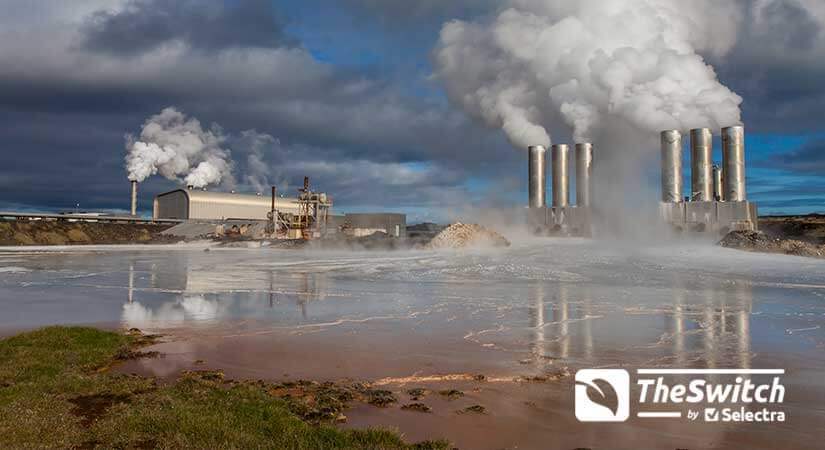What is Geothermal Energy? The Complete Guide

While there is significant potential for geothermal energy in the UK, it has been underexploited, with other renewables taking the lead. The UK has no active volcanic areas, but this doesn’t mean that there is a lack of potential for geothermal energy production. In this guide, we'll take a look at how we can add geothermal to our energy mix, the advantages and disadvantages of doing so, as well as the costs involved.

What is geothermal energy and how does it work?
Geothermal energy is heat stored below the earth’s surface. Since no fuel needs to be burned or consumed, it has much in common with other renewable resources and low-carbon options such as solar, wind, tidal and biomass.
It’s worth noting that the majority of the earth’s crust exceeds temperatures of 100ºC, meaning that trapped heat is plentiful. Ground heat is stored at various depths and several methods exist to extract it based on the depths and geological features being targeted.
What is an example of geothermal energy?
Geothermal power sources vary depending on what is containing the latent heat or causing a temperature difference that can be exploited for energy purposes.
Solar geothermal
Geothermal energy is stored at relatively shallow depths of around ten metres below the surface. The ground beneath your feet is constantly absorbing latent heat from solar energy. This means that this stored warmth is right there for the taking year-round and at relatively accessible depths.
When you reach 15 metres below the surface, the ground temperature is largely unaffected by what happens in the world above, provided the ground itself remains undisturbed. Since temperature remains constant at this depth, the difference between underground and overground temperatures can be effectively harnessed for heating purposes.
Water geothermal
While not the case in the UK, parts below the surface of some bodies of water in the vicinity of volcanoes can reach temperatures of 200ºC; effectively doubling water’s above-ground boiling point.
Additionally, depending on geological formations, volcanic water reservoirs can also be under pressure which further enhances their heat-storing properties. These liquid-dominated reservoirs or LDR’s don’t require pumps to circulate the water in either steam or liquid forms. Simply, deep wells can be dug up and the steam can then circulate through strategically placed turbines, generating electricity, before cooling back into a liquid and repeating the cycle. It goes without saying that geysers fall under this category too!
Geothermal Power Plant in MexicoThe Cerro Prieto geothermal plant in Northern Mexico is able to generate 750MW of electricity from superheated groundwater alone. The plant is actually made up of multiple artesian wells that power various turbines. In 2011, the geothermal facilities were augmented with a pilot solar farm to test out different solar PV technologies, with an initial capacity of 5MWe, expandandable to 30MWe if proven successful.
Groundwater doesn’t need to blast past boiling points to be useful in terms of sustainable energy generation. Water reserves with lower temperatures, ranging anywhere from 30ºC to 100ºC, can also be a source of energy. While powering turbines to make electricity may be out of the question at lower temperatures, these warm groundwater reservoirs can be used to power community or district heating projects.
While district heating is not widespread in the UK, geothermal energy could help to establish it as a practical alternative to costly and unreliable boiler based heating and hot water systems.
Deep Geothermal and Hot Rocks
The UK has sizeable granite deposits that actually run hotter than surrounding earth layers due to their unique mineral properties. As a result, these rocks can act as heaters or heat exchangers. It is possible to drill into these deposits, which naturally contain little to no water, in order to pump extraneous water into them, creating a viable steam circuit in the process.
The granite can heat the water at such high temperatures that it can be used to drive a turbine which, in turn, generates electricity. Cornwall is specifically suited to this type of large-scale geothermal energy project because of its significant granite deposits.
Great Britain - A historical geothermal pioneer?While legend has it that the Celtic royalty uncovered the thermal springs in modern-day Bath, it was the Romans who developed the site into the thermal baths we know and love. The Roman Baths exploit what is essentially a precursor to an enhanced geothermal system.
Advantages and disadvantages of Geothermal Energy
Geothermal energy is highly dependent on location to be a viable option. This is one of the reasons why it’s not as widespread in the UK compared to other parts of the world. However, when looking at the pros and cons below, the geographical excuse loses ground for not adopting the technology more enthusiastically.
Advantages of Geothermal Energy
Geothermal energy has some very unique characteristics when compared to other types of green energy. Let’s see what the advantages of geothermal energy are:
- Consistent energy output that can complement more weather-dependent green sources such as solar and wind. Geothermal is stable enough to seriously challenge nuclear energy, especially when taking safety into account.
- Scalable, meaning that everyone from single homes to large energy companies can leverage it based on their budget and needs.
- Durability is something shared by all geothermal energy technologies, no matter their size. Geothermal has low cost of overall ownership when looking at the long term.
Disadvantages of Geothermal Energy
While geothermal energy gives us a warm feeling here at The Switch, it is worth looking at some of its disadvantages, especially with regards to the British Isles.
- Cost is an issue due to the long-term nature of geothermal projects. Both residential and utility-scale projects are only for serious investors who have done their homework.
- Space demands are significant even when heating just a single home. Relatively large areas need to be dug up or drilled to install ground based heat pumps.
- Geographical limitations mean that the UK does not have the same access to superheated groundwater from volcanic formations as other countries that can use very unique geological features for their energy needs.
The UK hasn’t pursued geothermal energy as a serious green energy avenue due to a variety of geographical, political and economical factors. It’s not all bad news however, with some encouraging news coming out of Cornwall’s United Downs project that is designed to be both a testbed and demonstrator for future UK geothermal efforts.
Geothermal Engineering Ltd has been able to overcome funding hurdles dating back to the early 2010s and drill down into the Porthtowan Fault. This jewel of Cornish geology can heat up injected water to a blistering 195ºC. With the next step being a small geothermal plant capable of powering 3,000 homes and providing district heating with the right infrastructure, things are starting to look up for the fledgling UK geothermal industry.
There is really no reason for the UK to not be pushing harder for more geothermal energy. Government and private enterprise could drive up implementation at both the consumer and industrial ends of the market.
The Renewable Heat Incentive should be supplemented with easy access interest-free home improvement loans targeting older residences needing better insulation, as well as the energy efficiency that heat pumps bring to the table. The interest-free loan scheme has been piloted in Scotland, but it should be aggressively expanded to all Great Britain to lower the barrier of access to this energy efficient technology.

Geothermal costs and considerations
Geothermal projects, whether they are just for a home or a fully-fledged power station, are serious investments no matter their scale. Let’s take a look at how much different projects cost and key planning points to take into account.
Residential projects
Residential households can use shallow geothermal energy to drive a consumer heat pump system. Homeowners willing to go this route should have sufficient space to install a ground loop system. This key component contains the refrigerant that brings heat into the house. There are two main possibilities for ground loop installations:
- Horizontal ground loops involve digging up trenches to lay out piping at a specific depth. This is bound to tear up lawns and disturb landscaping features on the property.
- Diagonal or vertical loops take up less surface area, meaning less top soil is disturbed during installation, but the downside is that they have to be dug deeper, increasing initial project cost.
Ground source heat pump projects can easily run into the £20,000 to £30,000 range depending on the number of rooms the home has and whether heating and insulation get updated too. At the same time, homes and flats with little or no garden space would be better served by an Air Source Heat Pump system.
Residential projects involving heat pumps and geothermal energy need to be reinforced with suitable insulation and heater upgrades to reach the highest levels of efficiency possible. This allows them to provide the best savings and also the most beneficial environmental impact across the board.
Commercial projects
Heat pumps have real world benefits for commercial buildings and residential developments. Not only can heat pumps bring down heating bills,they will also make your property or business more attractive to qualified and increasingly sophisticated consumers taking a closer look at green business credentials when making choices about how to spend their money.
The UK government offers the Renewable Heat Incentive (RHI) which maximises return on investment beyond the intrinsic benefits of heat pump technology. With the scheme paying out green participants for up to 20 years at inflation-tracked rates, it certainly makes air and ground source heat pumps both financially attractive and fiscally responsible.
Another benefit for commercial and real estate ventures is the long term reliability and low cost of ownership that heat pumps bring to the table. Heat pumps have an established track record when it comes to operational lifetime.
While standard boiler reliability will begin to degrade after a decade, heat pumps can easily double that with a less intensive maintenance schedule which boosts reliability and uptime even further.
In terms of marketing and corporate responsibility, heat pumps have a significantly smaller carbon footprint than traditional commercial heating solutions. This can bring a business or property portfolio closer to socially responsible standards such as ISO 14001.
In addition to the aforementioned RHI payments, heat pumps open doors to schemes like the Green Business Fund which is administered by the Carbon Trust. This specific scheme can lower the barrier to entry for green technology significantly for SME energy users.
Our verdict: Geothermal not nuclear
From simple back of the napkin calculations based on statistics from the Union of Concerned Scientists, your average geothermal power station is four times cheaper than the average nuclear power plant today.
Comparing geothermal to nuclear is extremely relevant considering the UK is in the midst of debating how much more funding should be sunk into the nuclear industry. Nuclear power is often touted as the reliable stalwart of the UK energy mix, but that assessment ignores the serious cost and risk that it poses to future generations. Geothermal could fill that same stable role but without the costly decommissioning and fuel handling expense that nuclear reactors are saddled with.
Furthermore, nuclear energy is a rigid gamble in our increasingly agile economic landscape. A brand new nuclear power station is a colossal project with massive costs that magnify planning errors and overruns at the expense of taxpayers. Building a new nuclear power plant involves lengthy construction timelines and rigorous safety tests that delay the ability to produce power.
A geothermal power plant can be built incrementally, 20 to 30MW at a time. This means with any drilling or siting errors, engineers can correct the situation without impacting the overall success of the project. You can also start small and scale up according to success and available financing. In contrast with nuclear, geothermal represents a fiscally responsible choice.
The economic argument is only one part of the equation as geothermal renewable energy sources are, more importantly, the environmentally sound choice that will enhance the UK's green energy portfolio by playing to the strengths of other sustainable power options.
